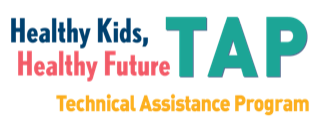Healthy kids,
healthy future
Promoting healthy habits today for a healthier tomorrow
RESOURCES FOR EARLY CARE & EDUCATION (ECE) PROFESSIONALS
Trainers
Access healthy eating and physical activity resources to train ECE providers on best practices.
ECE PROVIDERS
Get kids eating healthy and staying active in your ECE program.
FEATURED PROGRAMS & RESOURCES
Technical Assistance Program (TAP)
TAP builds state and ECE program capacity to embed healthy eating and physical activity best practices into ECE settings and systems.
Physical Activity Learning Sessions (PALS)
PALS is an out-of-the-box training for early care and education providers on physical activity.
Nourishing Healthy Preschoolers
Nourishing Preschoolers is an online course for early care and education (ECE) professionals.
EVENTS & RESOURCES

2024-2025 Springboard Opportunities
Offered by CDC and Nemours Children’s Health for States to Advance Early Care and Education Work.

Better Together was a project led by Nemours Children’s Health and Go NAPSACC
Implemented in Arizona, Arkansas, Indiana, and Mississippi, Better Together improved healthy eating and physical activity policies, environments, and practices within state systems and participating early care and education (ECE) programs.
EARLY CARE & EDUCATION SETTINGS CAN BUILD THE FOUNDATION FOR HEALTHY LIVING
Children spend many hours in early care and education (ECE) settings. ECE providers have an important role in influencing what children eat and how active they are throughout the day. Let’s help kids develop healthy habits early. Learn more about the 5 Healthy Goals to promote healthy growth and development.
Increase Physical Activity
Give kids daily opportunities to be active in safe spaces indoors and outdoors.
Improve Food Choices
Serve fruits, vegetables, and other healthy options. Healthy eating is essential for child development and long-term health.
Provide Healthy Beverages
Make water readily available. Hydrating the body is important so children can play, explore and learn throughout the day.
SUPPORT BREASTFEEDING
Create a breastfeeding friendly child care program. Learn more about the benefits of breastfeeding and how to support the feeding choices of all families.
Reduce Screen Time
Limit screen time in ECE settings. Staying active is a key for healthy development.

